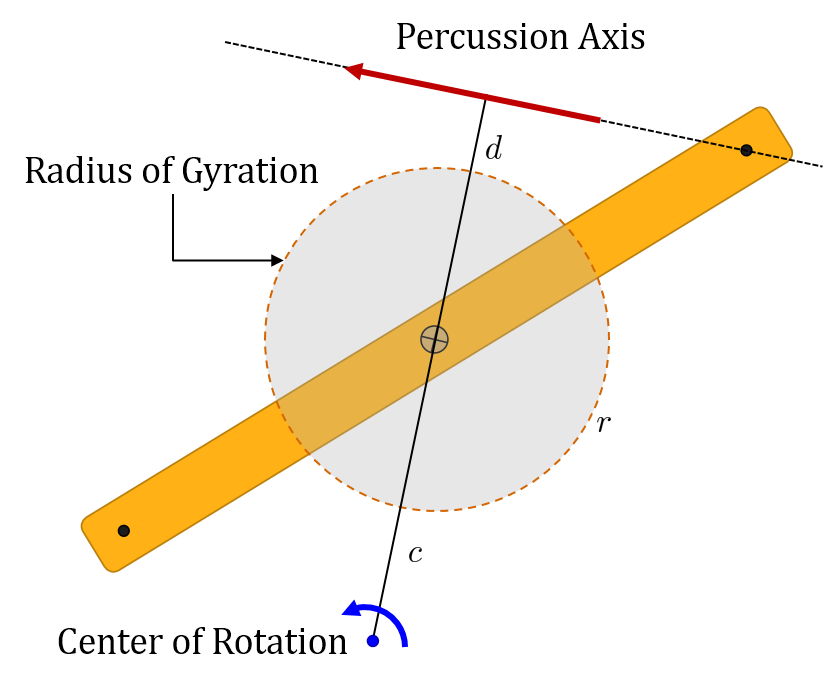Unless a pure torque is applied, a rigid body will never rotate about the center of mass only. But you are correct to consider the MMOI about the center of mass $I = \frac{m}{12} \ell^2$ as this will define the rotational motion.
- Motion of the center of mass $$ \boldsymbol{v}_C =\frac{1}{m} \boldsymbol{p} $$ where $\boldsymbol{p}$ is the aquired linear momentum after the impact
- Motion about the center of mass $$ \boldsymbol{\omega} = \mathrm{I}^{-1} \boldsymbol{L}_C$$ where $\boldsymbol{L}_C = \boldsymbol{r} \times \boldsymbol{p}$ is the angular momentum about the center of mass after the impact.
Axis of Rotation
If you know the motion of a point A on a rigid body ($\boldsymbol{v}_A$, $\boldsymbol{\omega}$) then the axis of rotation has the following properties
- Magnitude of rotation $$\omega = \| \boldsymbol{\omega} \|$$
- Direction of rotation $$\boldsymbol{z} = \frac{1}{\omega} \boldsymbol{\omega}$$
- Closest point on the axis of rotation $$ \boldsymbol{r}_{\rm rot} = \boldsymbol{r}_A + \frac{ \boldsymbol{\omega} \times \boldsymbol{v}_A}{ \omega^2 } $$
Where bold symbols are vectors, italic symbols are scalar, $\cdot$ is the dot product and $\times$ the vector cross product.
The planar expansion is
$$ \boldsymbol{r}_{\rm rot} = \pmatrix{x_A \\ y_A} + \frac{1}{\omega} \pmatrix{-\dot{y}_A \\ \dot{x}_A } $$
$(x_A,\,y_A)$ is the position of A and $(\dot{x}_A,\,\dot{y}_A)$ the velocity of A, and $\omega$ the rotational speed of the body.
Proof:
Expand $\boldsymbol{\omega} \times \boldsymbol{v}_A$ when the velocity of A is defined from the rotation as $\boldsymbol{v}_A = \boldsymbol{\omega} \times( \boldsymbol{r}_A - \boldsymbol{r}_{\rm rot}) = -\boldsymbol{\omega} \times \boldsymbol{r}$ where $\boldsymbol{r} = \boldsymbol{r}_{\rm rot} - \boldsymbol{r}_A$
$$ \require{cancel} \begin{aligned} \boldsymbol{\omega} \times \boldsymbol{v}_A & = \boldsymbol{\omega} \times ( -\boldsymbol{\omega} \times \boldsymbol{r})
\\ & = -\boldsymbol{\omega} (\cancelto{0}{ \boldsymbol{\omega} \cdot \boldsymbol{r}}) + \boldsymbol{r} ( \boldsymbol{\omega} \cdot \boldsymbol{\omega} ) = \boldsymbol{r}\, \omega^2
\end{aligned} $$
Axis of Momentum
Similarly given the momentum at a point A on a rigid body ($\boldsymbol{p}$, $\boldsymbol{L}_A$) the percussion axis is defined as
- Magnitude of momentum $$p = \| \boldsymbol{p} \|$$
- Direction of rotation $$\boldsymbol{e} = \frac{1}{p} \boldsymbol{p}$$
- Closest point on the axis of percussion $$ \boldsymbol{r}_{\rm per} = \boldsymbol{r}_A + \frac{ \boldsymbol{p} \times \boldsymbol{L}_A}{ p^2 } $$
Planar Case
There is special relationship in the planar cases. Consider the diagram below. The percussion axis is a perpendicular distance $d$ from the center of mass. The object has radius of gyration $r$. The center of rotation is on the other side of the center of mass at a distance $c$.
$$ \boxed{ c = \frac{r^2}{d} } $$

Example
A thin vertical rod of length $\ell$ and mass $m$ is punched/kicked at a location $d = \frac{1}{4} \ell$ above the center of mass. Find the center of rotation, and determine if end of the rod is going separate from the ground.
The mass moment of inertia is $I = \frac{m}{12} \ell^2$ so the radius of gyration is $r = \sqrt{ \frac{I}{m} } = \frac{\ell}{2 \sqrt{3}} $
The pivot location is $c = \frac{r^2}{d} = \frac{ \frac{1}{12} \ell^2}{ \frac{1}{2} \ell} =\frac{1}{6} \ell $ from the center of mass. From the end this is $\frac{\ell}{2} - \frac{\ell}{6} = +\frac{\ell}{3}$.
Since the center of rotation is above the end of the rod, the rod is going to loose contact with the ground, and not just slide along the ground.
References:

